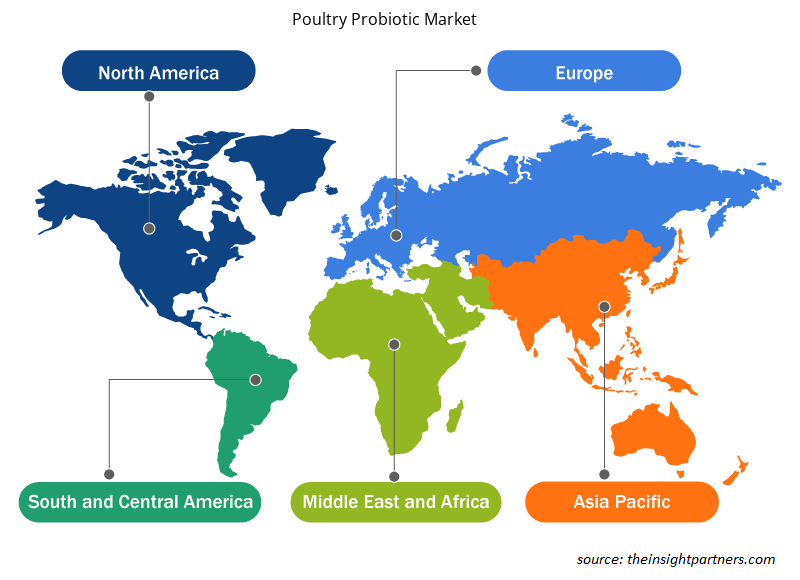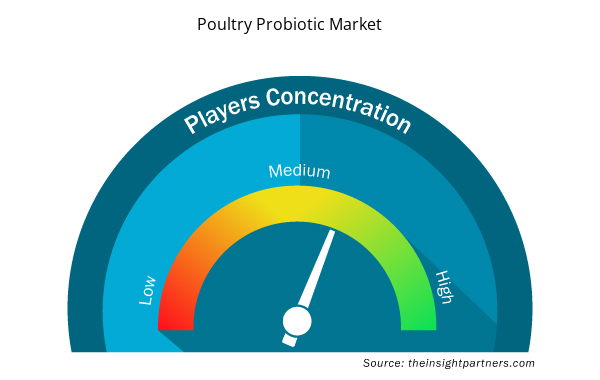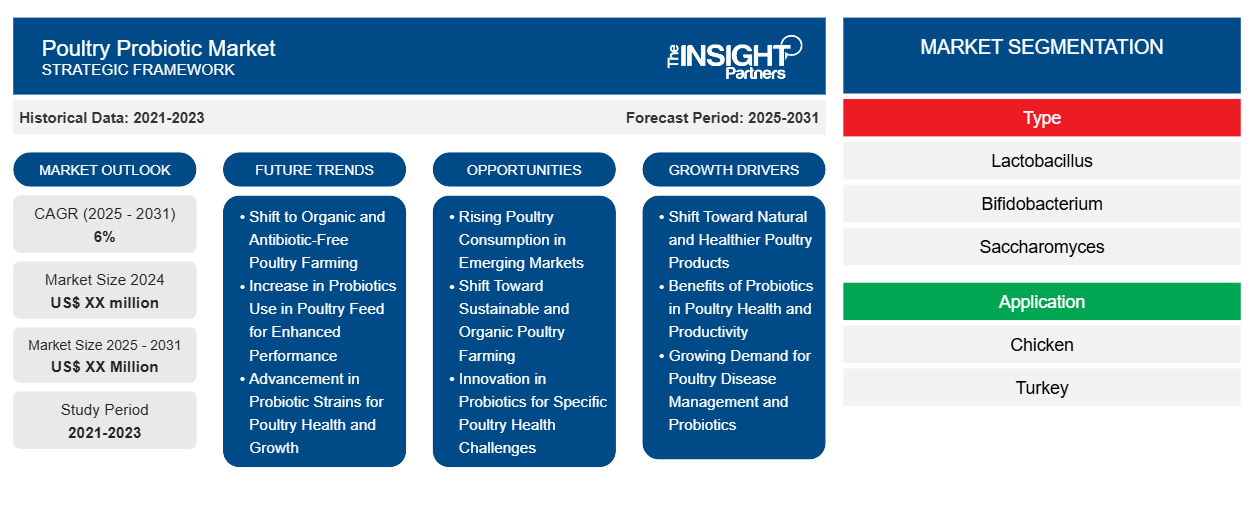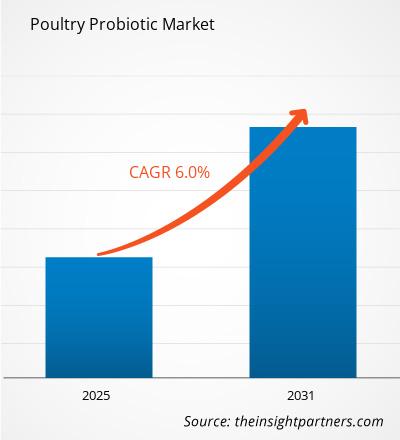Le marché des probiotiques pour la volaille devrait enregistrer un TCAC de 6 % de 2024 à 2031, avec une taille de marché passant de XX millions USD en 2024 à XX millions USD d'ici 2031.
Le rapport est segmenté par type (Lactobacillus, Bifidobacterium, Saccharomyces, Streptococcus et autres). Le rapport présente en outre une analyse basée sur l'application (poulet, dinde et autres). L'analyse mondiale est ensuite décomposée au niveau régional et par principaux pays. En termes de géographie, le marché est divisé en Amérique du Nord, Europe, Asie-Pacifique, Moyen-Orient et Afrique, et Amérique du Sud et centrale). Le rapport propose la valeur en USD pour l'analyse et les segments ci-dessus.
Objectif du rapport
Le rapport Poultry Probiotic Market de The Insight Partners vise à décrire le paysage actuel et la croissance future, les principaux facteurs moteurs, les défis et les opportunités. Cela fournira des informations à diverses parties prenantes commerciales, telles que :
- Fournisseurs/fabricants de technologie : pour comprendre l’évolution de la dynamique du marché et connaître les opportunités de croissance potentielles, leur permettant de prendre des décisions stratégiques éclairées.
- Investisseurs : Effectuer une analyse complète des tendances concernant le taux de croissance du marché, les projections financières du marché et les opportunités qui existent tout au long de la chaîne de valeur.
- Organismes de réglementation : Réglementer les politiques et surveiller les activités du marché dans le but de minimiser les abus, de préserver la confiance des investisseurs et de maintenir l’intégrité et la stabilité du marché.
Segmentation du marché des probiotiques pour volaille
Taper
- Lactobacille
- Bifidobactérie
- Saccharomyces
- Streptocoque
Application
- Poulet
- Turquie
Personnalisez ce rapport en fonction de vos besoins
Vous bénéficierez d'une personnalisation gratuite de n'importe quel rapport, y compris de certaines parties de ce rapport, d'une analyse au niveau des pays, d'un pack de données Excel, ainsi que de superbes offres et réductions pour les start-ups et les universités.
- Obtenez les principales tendances clés du marché de ce rapport.Cet échantillon GRATUIT comprendra une analyse de données, allant des tendances du marché aux estimations et prévisions.
Facteurs de croissance du marché des probiotiques pour la volaille
- L'évolution vers des produits de volaille plus naturels et plus sains : La tendance croissante des consommateurs à privilégier des produits de volaille plus naturels et plus sains entraîne une réduction de l'utilisation d'antibiotiques dans la production de volaille. Une alternative à l'utilisation d'antibiotiques, à savoir un probiotique pour la volaille, gagne en popularité et stimule donc le marché.
- Avantages des probiotiques pour la santé et la productivité des volailles : Chez les volailles, l'utilisation de probiotiques améliore la digestion, l'absorption des nutriments et la santé des oiseaux, ce qui conduit à une productivité accrue. À mesure que les agriculteurs sont mieux informés sur le rôle des probiotiques dans l'amélioration du bien-être des animaux et la diminution du taux de mortalité, leur utilisation augmente, contribuant ainsi à la croissance du marché.Probiotics in Poultry Health and Productivity: In poultry, the use of probiotics enhances digestion, nutrient uptake and the health of the birds, all of which lead to improved productivity. As farmers become more informed about the role of probiotics in enhancing the welfare of animals and decreasing the mortality rate, their use is rising thus contributing to the growth of the market.
- Demande croissante en matière de gestion des maladies des volailles et de probiotiques : Compte tenu de l'augmentation de la population et de la consommation de viande de volaille et d'œufs, en particulier dans les pays du tiers monde, il existe une demande pour une meilleure gestion des maladies des volailles. Les probiotiques permettent un meilleur taux de conversion alimentaire et offrent une bonne santé aux animaux, fournissant ainsi un facteur de production supplémentaire important qui augmente la croissance du marché.Probiotics: Considering the increase in population and consumption of poultry meat and eggs most particularly in the third world countries, there is a demand for better management of poultry diseases. Probiotics allow a better feed conversion ratio and offers good health to the animals, thus providing an important supplementary factor of production which is increasing market growth.
Tendances futures du marché des probiotiques pour volailleProbiotic Market Future Trends
- Passage à l'élevage de volaille biologique et sans antibiotiques : l'utilisation d'additifs synthétiques et d'antibiotiques est remplacée par l'utilisation de produits plus biologiques tels que les probiotiques pour volaille. Les consommateurs demandant davantage de poulet propre et sans porc, les éleveurs utilisent des produits sans antibiotiques tels que les probiotiques pour garantir des animaux sains et productifs, en tandem avec des méthodes d'élevage respectueuses de l'environnement.probiotics. As the consumers request more clean, pork free chicken, the farmers are utilizing antibiotics free products such as probiotics to ensure healthy and productive animals in tandem with environmentally friendly farming methods.
- Augmentation de l'utilisation des probiotiques dans l'alimentation des volailles pour une meilleure performance : L'incorporation de probiotiques dans les aliments composés est désormais en augmentation. Les agriculteurs et les producteurs d'aliments cherchent à améliorer l'alimentation des volailles en utilisant la recherche sur les probiotiques afin d'améliorer la santé intestinale et les performances générales des oiseaux et de faciliter ainsi l'approche intégrée et holistique de la nutrition des volailles pratiquée aujourd'hui.Probiotics Use in Poultry Feed for Enhanced Performance: The incorporation of probiotics in compounded feeds is now on the increase. Farmers and feed producers seek to enhance the diets of poultry by utilizing probiotic research in order to improve on the birds’ gut health and general performance and therefore facilitating the integrated and holistic approach to poultry nutrition practiced today.
- Progrès dans les souches probiotiques pour la santé et la croissance des volailles : Sur le marché des probiotiques pour la volaille, des changements de tendance dans la croissance des souches probiotiques peuvent être observés à mesure que des produits plus modérés conçus pour répondre à la demande des clients en matière de santé des volailles apparaissent. Les tendances du marché évoluent à mesure que des probiotiques révolutionnaires destinés à prévenir les maladies et à favoriser la croissance des volailles sont fabriqués grâce aux progrès de la technologie microbienne.Probiotic Strains for Poultry Health and Growth: In poultry probiotic market growth trend changes in probiotic strains can be observed as more moderated products designed for customer demand in poultry health appear. There are changing trends in regard to the market as revolutionized probiotics intended to prevent diseases and promote growth of poultry are being manufactured due to advancement in microbial technology.
Opportunités de marché pour les probiotiques pour la volaille
- Augmentation de la consommation de volaille dans les marchés émergents : les pays émergents, notamment en Asie et en Afrique, augmentent leur consommation de volaille, ce qui ouvre la voie à l'utilisation de probiotiques pour améliorer la santé et la production de volailles. L'émergence de pratiques agricoles modernes dans ces régions a créé un besoin de probiotiques dans l'aviculture.
- Vers un élevage de volaille durable et biologique : L’attention accrue portée à l’élevage de volaille durable et biologique met immédiatement en évidence les possibilités d’utilisation des probiotiques. De plus, les additifs naturels aident à lutter contre la crainte d’une utilisation excessive d’antibiotiques, car de plus en plus de consommateurs demandent des produits de volaille biologiques sans antibiotiques.
- Innovation dans les probiotiques pour les problèmes de santé spécifiques de la volaille : il existe une opportunité d'innover et de fournir des probiotiques spécifiques qui s'attaquent à la santé intestinale, aux interventions contre les maladies et aux problèmes de prise de poids de la volaille. Le marché de la volaille est également susceptible de connaître une croissance grâce à la fourniture de différentes solutions destinées aux différents stades de croissance de la volaille ou même à différentes races de volaille.
Aperçu régional du marché des probiotiques pour volaille
Les tendances régionales et les facteurs influençant le marché des probiotiques pour volaille tout au long de la période de prévision ont été expliqués en détail par les analystes d’Insight Partners. Cette section traite également des segments et de la géographie du marché des probiotiques pour volaille en Amérique du Nord, en Europe, en Asie-Pacifique, au Moyen-Orient et en Afrique, ainsi qu’en Amérique du Sud et en Amérique centrale.

- Obtenez les données régionales spécifiques au marché des probiotiques pour la volaille
Portée du rapport sur le marché des probiotiques pour volaille
| Attribut de rapport | Détails |
|---|---|
| Taille du marché en 2024 | XX millions de dollars américains |
| Taille du marché d'ici 2031 | XX millions de dollars américains |
| Taux de croissance annuel composé mondial (2025-2031) | 6% |
| Données historiques | 2021-2023 |
| Période de prévision | 2025-2031 |
| Segments couverts | Par type
|
| Régions et pays couverts | Amérique du Nord
|
| Leaders du marché et profils d'entreprises clés |
|
Densité des acteurs du marché des probiotiques pour volailles : comprendre son impact sur la dynamique commerciale
Le marché des probiotiques pour volaille connaît une croissance rapide, tirée par la demande croissante des utilisateurs finaux en raison de facteurs tels que l'évolution des préférences des consommateurs, les avancées technologiques et une plus grande sensibilisation aux avantages du produit. À mesure que la demande augmente, les entreprises élargissent leurs offres, innovent pour répondre aux besoins des consommateurs et capitalisent sur les tendances émergentes, ce qui alimente davantage la croissance du marché.
La densité des acteurs du marché fait référence à la répartition des entreprises ou des sociétés opérant sur un marché ou un secteur particulier. Elle indique le nombre de concurrents (acteurs du marché) présents sur un marché donné par rapport à sa taille ou à sa valeur marchande totale.
Les principales entreprises opérant sur le marché des probiotiques pour la volaille sont :
- SMA
- Chr. Hansen Holding A/S
- Adisseo
- Tout-Tech
- Terres O'Lakes, Inc.
Avis de non-responsabilité : les sociétés répertoriées ci-dessus ne sont pas classées dans un ordre particulier.

- Obtenez un aperçu des principaux acteurs du marché des probiotiques pour volaille
Principaux arguments de vente
- Couverture complète : Le rapport couvre de manière exhaustive l’analyse des produits, des services, des types et des utilisateurs finaux du marché des probiotiques pour la volaille, offrant un paysage holistique.
- Analyse d’experts : Le rapport est compilé sur la base d’une compréhension approfondie des experts et analystes du secteur.
- Informations à jour : Le rapport garantit la pertinence commerciale en raison de sa couverture des informations récentes et des tendances des données.
- Options de personnalisation : ce rapport peut être personnalisé pour répondre aux exigences spécifiques du client et s'adapter parfaitement aux stratégies commerciales.
Le rapport de recherche sur le marché des probiotiques pour volaille peut donc aider à ouvrir la voie au décodage et à la compréhension du scénario de l’industrie et des perspectives de croissance. Bien qu’il puisse y avoir quelques préoccupations valables, les avantages globaux de ce rapport ont tendance à l’emporter sur les inconvénients.
- Analyse historique (2 ans), année de base, prévision (7 ans) avec TCAC
- Analyse PEST et SWO
- Taille du marché Valeur / Volume - Mondial, Régional, Pays
- Industrie et paysage concurrentiel
- Ensemble de données Excel



Report Coverage
Revenue forecast, Company Analysis, Industry landscape, Growth factors, and Trends

Segment Covered
This text is related
to segments covered.

Regional Scope
North America, Europe, Asia Pacific, Middle East & Africa, South & Central America

Country Scope
This text is related
to country scope.
Questions fréquemment posées
Increasing awareness of animal health and productivity and rising demand for antibiotic-free poultry products are driving the market growth.
A key trend in the poultry probiotic market is the growing trend of replacing synthetic additives and antibiotics with natural alternatives.
ADM, Chr. Hansen Holding A/S, Adisseo, Alltech, Land O'Lakes, Inc, Lallemand Inc., DSM, IFF Nutrition and Biosciences, Kemin Industries, Inc. are the key players operating in the poultry probiotic market.
Based on geography, North America held the largest share of the poultry probiotic market.
The report can be delivered in PDF/Word format, we can also share excel data sheet based on request.
The Poultry Probiotic Market is estimated to witness a CAGR of 6% from 2023 to 2031
Trends and growth analysis reports related to Food and Beverages : READ MORE..
The Insight Partners performs research in 4 major stages: Data Collection & Secondary Research, Primary Research, Data Analysis and Data Triangulation & Final Review.
- Data Collection and Secondary Research:
As a market research and consulting firm operating from a decade, we have published and advised several client across the globe. First step for any study will start with an assessment of currently available data and insights from existing reports. Further, historical and current market information is collected from Investor Presentations, Annual Reports, SEC Filings, etc., and other information related to company’s performance and market positioning are gathered from Paid Databases (Factiva, Hoovers, and Reuters) and various other publications available in public domain.
Several associations trade associates, technical forums, institutes, societies and organization are accessed to gain technical as well as market related insights through their publications such as research papers, blogs and press releases related to the studies are referred to get cues about the market. Further, white papers, journals, magazines, and other news articles published in last 3 years are scrutinized and analyzed to understand the current market trends.
- Primary Research:
The primarily interview analysis comprise of data obtained from industry participants interview and answers to survey questions gathered by in-house primary team.
For primary research, interviews are conducted with industry experts/CEOs/Marketing Managers/VPs/Subject Matter Experts from both demand and supply side to get a 360-degree view of the market. The primary team conducts several interviews based on the complexity of the markets to understand the various market trends and dynamics which makes research more credible and precise.
A typical research interview fulfils the following functions:
- Provides first-hand information on the market size, market trends, growth trends, competitive landscape, and outlook
- Validates and strengthens in-house secondary research findings
- Develops the analysis team’s expertise and market understanding
Primary research involves email interactions and telephone interviews for each market, category, segment, and sub-segment across geographies. The participants who typically take part in such a process include, but are not limited to:
- Industry participants: VPs, business development managers, market intelligence managers and national sales managers
- Outside experts: Valuation experts, research analysts and key opinion leaders specializing in the electronics and semiconductor industry.
Below is the breakup of our primary respondents by company, designation, and region:

Once we receive the confirmation from primary research sources or primary respondents, we finalize the base year market estimation and forecast the data as per the macroeconomic and microeconomic factors assessed during data collection.
- Data Analysis:
Once data is validated through both secondary as well as primary respondents, we finalize the market estimations by hypothesis formulation and factor analysis at regional and country level.
- Macro-Economic Factor Analysis:
We analyse macroeconomic indicators such the gross domestic product (GDP), increase in the demand for goods and services across industries, technological advancement, regional economic growth, governmental policies, the influence of COVID-19, PEST analysis, and other aspects. This analysis aids in setting benchmarks for various nations/regions and approximating market splits. Additionally, the general trend of the aforementioned components aid in determining the market's development possibilities.
- Country Level Data:
Various factors that are especially aligned to the country are taken into account to determine the market size for a certain area and country, including the presence of vendors, such as headquarters and offices, the country's GDP, demand patterns, and industry growth. To comprehend the market dynamics for the nation, a number of growth variables, inhibitors, application areas, and current market trends are researched. The aforementioned elements aid in determining the country's overall market's growth potential.
- Company Profile:
The “Table of Contents” is formulated by listing and analyzing more than 25 - 30 companies operating in the market ecosystem across geographies. However, we profile only 10 companies as a standard practice in our syndicate reports. These 10 companies comprise leading, emerging, and regional players. Nonetheless, our analysis is not restricted to the 10 listed companies, we also analyze other companies present in the market to develop a holistic view and understand the prevailing trends. The “Company Profiles” section in the report covers key facts, business description, products & services, financial information, SWOT analysis, and key developments. The financial information presented is extracted from the annual reports and official documents of the publicly listed companies. Upon collecting the information for the sections of respective companies, we verify them via various primary sources and then compile the data in respective company profiles. The company level information helps us in deriving the base number as well as in forecasting the market size.
- Developing Base Number:
Aggregation of sales statistics (2020-2022) and macro-economic factor, and other secondary and primary research insights are utilized to arrive at base number and related market shares for 2022. The data gaps are identified in this step and relevant market data is analyzed, collected from paid primary interviews or databases. On finalizing the base year market size, forecasts are developed on the basis of macro-economic, industry and market growth factors and company level analysis.
- Data Triangulation and Final Review:
The market findings and base year market size calculations are validated from supply as well as demand side. Demand side validations are based on macro-economic factor analysis and benchmarks for respective regions and countries. In case of supply side validations, revenues of major companies are estimated (in case not available) based on industry benchmark, approximate number of employees, product portfolio, and primary interviews revenues are gathered. Further revenue from target product/service segment is assessed to avoid overshooting of market statistics. In case of heavy deviations between supply and demand side values, all thes steps are repeated to achieve synchronization.
We follow an iterative model, wherein we share our research findings with Subject Matter Experts (SME’s) and Key Opinion Leaders (KOLs) until consensus view of the market is not formulated – this model negates any drastic deviation in the opinions of experts. Only validated and universally acceptable research findings are quoted in our reports.
We have important check points that we use to validate our research findings – which we call – data triangulation, where we validate the information, we generate from secondary sources with primary interviews and then we re-validate with our internal data bases and Subject matter experts. This comprehensive model enables us to deliver high quality, reliable data in shortest possible time.


 Obtenez un échantillon gratuit pour ce rapport
Obtenez un échantillon gratuit pour ce rapport